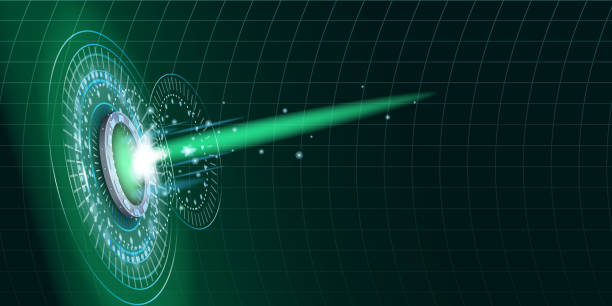INTRODUCTION
Laser, also known as LASER, refers to “light amplification by stimulated emission of radiation,” and the name was given to Gordon Gould in 1957. Before this, the laser was called the optical MASER’, a different acronym that translates to “microwave amplification by stimulated emission of radiation.” However, both applications have their roots at the start of the century. In 1917, the most well-known of them all, Albert Einstein put forward his theory of “stimulated emission’.
This article aims to provide a basic introduction to lasers for the beginner. Lasers are highly complex, and a lot of information is needed, but we hope to provide enough information to allow the reader to comprehend how lasers were created, how they were developed, and an overview of their present use in medicine.
LASER; THE PHYSICS
Visible light is the term used to describe the type of electromagnetic radiation that is apparent to our eyes. In this spectrum, the electromagnetic spectrum is not complete and includes the wavelengths of infrared and ultraviolet. Electromagnetic radiation is absorbed when it travels through biological tissues. The tissue that is absorbent is described as having thermal or photochemical properties. Radiation energy that is too strong can harm tissue, leading to mechanical effects.
Light travels along a straight line or Ray unless perturbed. In general space, light scatters and thus reduces its intensity. The principle behind lasers is to maximize the power of light to create an end-to-end destructive force. This is accomplished by using one color or wavelength transmitted with a narrow beam and creating an additive effect on its final destination.
These principles are essential to laser technology. They are described as generating a ‘monochromatic’ ‘collimated, and ‘coherent’ beam of light.
The absorption is reduced when using light with specific wavelengths, except for the specific substance. In particular, a laser light source is coherent (all the light waves are in phase) and monochromatic (single wavelength). In addition, they travel within the exact direction and can therefore be described as collimated. The term “irradiance” refers to the sizeable radiant potential of the laser in a given area because it is concentrated within a small band.
Laser light is produced by stimulating a well-known material (media) in order to take up energy. When the light stimulates the substance, electrons within the media shift towards higher energy. This unstable state immediately returns the electron to its normal condition and produces power in the shape of photons. The term “population inversion” is the term used to describe the number of atoms that are present when they are excited in comparison to the number of atoms in their regular or ground state.
If this photon triggers an atom of the same media within its unstabilized state, an additional photon is released, stimulating the emission of photons. Because the media is composed of particular atoms, the photons emitted from each have one wavelength. The knock-on effect allows the next identical wavelength light to propagate in the exact direction in a specific way, creating coherence across the entire media.
LASER; LASING
The laser’s media is stimulated by firing the light (pumping) across it. The photons produced by the media are then reflected in the cavity of mirrors, which amplifies the photons and, consequently, energy. The cascade effect can move the photons into the beam until they reach the partial mirrors in which some photos are released. This is the result of the laser output, which, if focused, could result in a greater power density. The light produced by this method is concentrated into the most narrow range of wavelengths and produces the most pure monochromatic light available (Fig. 1).
The medium, or the ‘lasing media,’ is needed to be stimulated by photons. It is typically a liquid, gas crystal, semiconductor or. There are various methods for activating the lasing medium, such as high voltage discharge or continuous light or light from a flashlight, radio-frequency radiation, or even light from a different laser.
Fig. (1 ). 1) Light is directed into the laser cavity, stimulating the atoms 2.) The atoms release photons when they start to return back to their original condition, after which the light pumping will stimulate them. 3) The photons begin to wander around randomly, but they stimulate photon generation. 4.) The photons reflect off several mirrors (grey) that allow photons to cascade through the media and into the laser cavity towards the laser and half-mirror. The light that enters the cavity is, at this point, all from one source (monochromatic) that is traveling at the same speed (collimated) and at the same rate (coherent), and thus, it is the light from a laser that gets created.
LASER; HISTORY OF ITS DISCOVERY AND APPLICATION
In the year 1900, Max Plank found, during his studies of the radiance of light, frequency, and temperature, that light was a type of electromagnetic radiation 11. Before that, the knowledge of science regarding light was limited to studying its behavior and characteristics. But the mechanism through which light is generated still needs to be understood.
In 1917, Albert Einstein described the theory of the stimulation of emission in his work “on quantum theory of radiation” 2]. 22. The theory was that:
- Light travels as photons, which are energy units and
- Most atoms are in the standard energy level called the ground stage (E0). However, only a handful of natural fractions occur in higher energy levels (E1, E2, E2, E3, … En).
Einstein believed that by increasing the energy of electrons in the E the 0 conditions, the atoms could become excited at a more level of energy. After their excitation to an energy level higher than their previous one, their return or decline to their energy level of E zero. In this process, particles release the energy they accumulate naturally through electromagnetic waves or photons. This is the foundation of stimulated emission, which is the main concept in the evolution of the laser (Fig. 2).
Fig. (2 ). Transition of light that stimulates electrons into higher energy states like E1 and E2 during laser emission.
Scientists were interested in radar technology and the microwave light spectrum during the Second World War. In the postwar era, physicists sought to amplify the emission of light stimulated at less wavelength than the microwave spectrum. Charles Townes built the first MASER in 1954 at Columbia University in New York. In the Lebedev laboratory at the Lebedev laboratory in Moscow, Alexander Prokhorov and Nikolai Basov built a maser prototype. The result was three men receiving the 1964 Nobel Prize for Physics with each other for their work in the field of stimulated emission 33.
Forty-three years after Einstein introduced his theory on quantum radiation, on the 26 of May 1960, 1960 Dr. Theodor Harold Maiman demonstrated the first laser that was operational 4Theodor Harold Maiman showed the first operational laser [ 4. Maiman introduced the very first visible light laser made of a silver-coated crystal with flashlamps, mirrors and.
Gases like nitrogen, Carbon dioxide (CO2), and Helium-Neon combined (He-Ne) comprised the main mediums used in the early series of lasers. In 1961, the very first He-Ne laser (wavelength 1.15 nm) was created by Ali Javan [ 55. The year before, the Neodymium laser’s first version was created. In 1961, the first Neodymium laser was invented 6[ 6. Genesis et al. [7] published the 1st laser using Yttrium-Aluminium-Garnet (YAG laser) in 1964. Additional gas lasers have been developed via Patel (CO 2 laser) [8] 8 as well as Bridges (argon laser) (argon laser) 99. It was in the year 1966 that Soarokin and Lankard 10] 10developed the first dye laser based on ruby, and liquids were employed as the primary medium.
The range of media has widened, and so has the application of lasers across industries. It was only a short time before lasers were integrated into medicine to aid their therapeutic purposes. Nowadays, they are utilized across many medical and surgical procedures, and their usage and demand continue to grow.
LASER; LASER USE IN MEDICINE
It is believed that the ancient Greeks, as well as Egyptians, believed in utilizing the sun as a method of treatment of illness. Nowadays, lasers are used in medicine for both therapeutic and diagnostic purposes, and their wavelengths range from infrared through UV 1111. A list of the most popular laser-related uses can be found in Table 1. (Table 1 12to 45[ 12-45].
Different factors influence the interaction of lasers with human tissue. These include scattering, absorption, and pulsed and continuous waves. Water is the main absorber for wavelengths greater than 1 millimeter. Other absorbers have hemoglobin, blood proteins, and melanin, a pigment in the skin. Similar to how absorbing different wavelengths of light alters the hue of light using dyes, they can be used to treat diseases and allow the control of specific tissues that are targeted. One example could be treatments for oesophageal and urinary tract cancerous tumors. The dye hematoporphyrin acts as a photosensitizer during photodynamic therapy. It absorbs waves that are in the range of 630nm.




